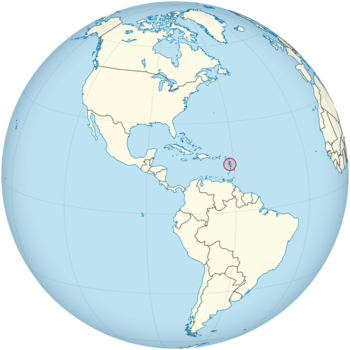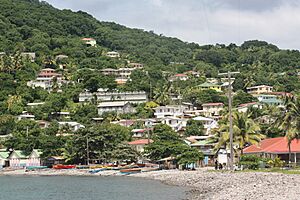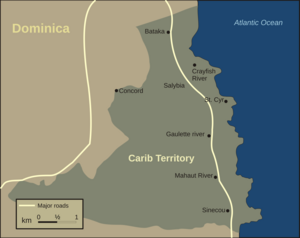Dominica facts for kids
Quick facts for kids
Commonwealth of Dominica
Waitukubuli (Island Carib)
Dominik (Dominican Creole French) |
|
|---|---|
|
|
|
|
Motto: "Apres Bondie, C'est La Ter" (Dominican Creole French)
"Post Deum terra est" (Latin) "After God is the earth" |
|
|
Anthem: "Isle of Beauty, Isle of Splendour"
|
|

Location of Dominica (circled in red)
in the Western Hemisphere |
|
| Capital and largest city
|
Roseau 15°18′N 61°23′W / 15.300°N 61.383°W |
| Official languages | English |
| Vernacular languages |
Dominican Creole French |
| Ethnic groups
(2014)
|
|
| Religion
(2020)
|
|
| Demonym(s) | Dominican (pronounced) |
| Government | Unitary dominant-party parliamentary republic |
| Sylvanie Burton | |
| Roosevelt Skerrit | |
|
• Speaker of the House of Assembly
|
Joseph Isaac |
| Legislature | House of Assembly |
| Independence
from the United Kingdom
|
|
|
• West Indies Associated States
|
1 March 1967 |
|
• Sovereignty and constitution
|
3 November 1978 |
| Area | |
|
• Total
|
750 km2 (290 sq mi) (174th) |
|
• Water (%)
|
1.6 |
| Population | |
|
• 2018 estimate
|
71,625 (186th) |
|
• 2011 census
|
72,000 |
|
• Density
|
105/km2 (271.9/sq mi) (95th) |
| GDP (PPP) | 2018 estimate |
|
• Total
|
$688 million |
|
• Per capita
|
$9,726 |
| GDP (nominal) | 2018 estimate |
|
• Total
|
$485 million |
|
• Per capita
|
$7,860 |
| HDI (2022) | high · 97th |
| Currency | East Caribbean dollar (XCD) |
| Time zone | UTC–4 (AST) |
| Driving side | left |
| Calling code | +1-767 |
| ISO 3166 code | DM |
| Internet TLD | .dm |
Dominica is an island country in the Caribbean Sea. It is officially called the Commonwealth of Dominica. The island is part of the Windward Islands chain, which is in the Lesser Antilles. Its capital city, Roseau, is on the western side of the island. Dominica's closest neighbors are Guadeloupe to the northwest and Martinique to the south-southeast.
Dominica covers about 750 square kilometers (290 square miles). Its highest point is Morne Diablotins, which is 1,447 meters (4,747 feet) high. In 2011, about 71,293 people lived there.
The island was first settled by the Arawak people around the 5th century. Later, the Kalinago people arrived and became the main group by the 15th century. Christopher Columbus is believed to have seen the island on Sunday, November 3, 1493. Europeans, mainly the French, later colonized it from the 1690s to 1763. The French brought enslaved people from West Africa to work on coffee farms. Great Britain took control in 1763 after a war, and English slowly became the official language. Dominica became an independent country in 1978.
Dominica is known as the "Nature Island of the Caribbean" because of its beautiful natural environment. It is the youngest island in the Lesser Antilles and is still being formed by geothermal and volcanic activity. You can see this at the Boiling Lake, which is the world's second-largest hot spring. The island has thick mountainous rainforests and is home to many rare plants, animals, and birds. The Sisserou parrot, also called the Imperial Amazon, is very rare and lives only in Dominica. It is the island's national bird and is even on the national flag. This makes Dominica one of only two countries whose flag has the color purple! Dominica is a member of important international groups like the Commonwealth of Nations and the United Nations.
Contents
What Does "Dominica" Mean?
The native Carib people called the island Wai‘tu kubuli, which means "Tall is her body."
Christopher Columbus named the island Dominica. He saw it on a Sunday in November 1493, and "Dominica" comes from the Latin term dies Dominica, meaning "Sunday."
The name Dominica is pronounced with the stress on the third syllable, like "dom-in-EE-ka."
A Brief Look at Dominica's History
How the Island Was Formed
Dominica rose from the sea about 67 million years ago. This makes it one of the last Caribbean islands to be created by volcanic activity.
Early People and European Visitors
The first people to live in Dominica were the Island Carib people, also known as Kalinago. They are thought to have replaced the earlier Arawak population.
In 1493, Christopher Columbus saw the island during his second trip to the Americas. He named it Dominica because he saw it on a Sunday. Some Spanish settlers tried to live there, but the Kalinago people from other islands moved to Dominica and made it difficult for the Spanish to stay.
French Influence
Spain did not have much success in colonizing Dominica. In 1632, France claimed the island, but they did not physically settle it right away. French woodcutters from nearby islands began to settle permanently in the 1690s. They brought the first enslaved Africans to the island, which they called Dominique.
By 1727, France officially made Dominica a colony. They started coffee farms, and many enslaved African people were brought to work on these plantations.
British Control and Independence
In 1761, during the Seven Years' War, British forces took over Dominica. In 1763, France gave the island to Great Britain. The British set up a government, but only European colonists could be part of it. French was still the main language spoken by most people.
In 1778, the French tried to take back Dominica, but the island was returned to British control in 1783. Great Britain kept control even through more French invasions in 1795 and 1805.
Britain officially made Dominica a small colony in 1805. They used the island as part of the Atlantic slave trade, bringing enslaved people from Africa to work on sugar and coffee farms.
In 1831, a law called the Brown Privilege Bill gave political and social rights to free people of African descent. In 1833, Britain ended slavery throughout its empire. After slavery ended, many people of African descent were elected to the government.
In 1871, Dominica became part of the British Leeward Islands. Over time, the power of the elected government was reduced, and in 1896, the British government took more direct control.
Moving Towards Self-Rule
After World War I, many Dominicans wanted more say in their government. In 1940, Dominica's administration was moved to the British Windward Islands.
From 1958 to 1962, Dominica was part of the short-lived West Indies Federation. After it broke up, Dominica became an associated state of the United Kingdom in 1967. This meant it was responsible for its own internal affairs. Finally, on November 3, 1978, the Commonwealth of Dominica became a fully independent country.
Recent Times
After gaining independence, Dominica faced some challenges. In 1979, Hurricane David caused a lot of damage. Another storm, Hurricane Allen, hit the next year.
In 1980, Eugenia Charles became the Prime Minister. She was the first female prime minister in the Caribbean. Her government faced some challenges, including attempts to overthrow it.
The economy started to get better in the mid-1980s, but then banana prices dropped. Prime Minister Charles won elections in 1985 and 1990. After she left politics, Edison James became prime minister in 1995. He tried to make the economy less dependent on bananas, especially after Hurricane Luis damaged the crop.
In 2000, Roosevelt B. "Rosie" Douglas became prime minister, but he passed away later that year. Pierre Charles took over, but he also passed away in 2004. Then, Roosevelt Skerrit became prime minister at the age of 31, making him the youngest head of government in the world at that time. He has won several elections since then.
In 2015, Tropical Storm Erika caused widespread flooding and landslides, killing many people and causing huge damage. In 2017, Hurricane Maria, a very strong Category 5 hurricane, hit the island directly. It destroyed most buildings and left the country in ruins. Many countries helped Dominica with aid.
In 2024, Thea LaFond won Dominica's first Olympic gold medal in the women's triple jump at the 2024 Summer Olympics in Paris.
Dominica's Geography and Climate
Dominica is an island nation in the Caribbean Sea. It is about 47 kilometers (29 miles) long and 26 kilometers (16 miles) wide.
It is known as "The Nature Island of the Caribbean" because of its beautiful scenery and many plants and animals. Most of Dominica is covered by rainforest. It is home to the world's second-largest hot spring, Boiling Lake. The island has many volcanic peaks, with Morne Diablotins being the highest. Morne Trois Pitons National Park is a tropical forest with volcanic features. It was named a World Heritage Site in 1995.
Some plants and animals that are extinct on other islands can still be found in Dominica's forests. The island has many protected areas and 365 rivers! The government has been working to make Dominica a great place for ecotourism.
The two main towns are the capital, Roseau, and Portsmouth. Most people live along the coast, while the mountainous middle of the island is not very populated.
Dominica is in a region where hurricanes often happen. In 1979, Hurricane David caused a lot of damage. In 2007, Hurricane Dean also hit the island. In 2015, Tropical Storm Erika caused huge floods and landslides. Then, in 2017, Hurricane Maria caused even more destruction, damaging almost all buildings.
Amazing Animals of Dominica
The Sisserou parrot is Dominica's national bird. It lives only in the mountain forests of Dominica. Another rare parrot, the Jaco or red-necked parrot, also lives here. Both are protected, but their homes are still threatened by logging and hurricanes.
Dominica has at least four types of snakes and 11 types of lizards. It is also the last main home for the very rare Lesser Antillean iguana.
The waters around Dominica are home to many cetaceans, which are marine mammals like whales and dolphins. You can often see sperm whales, spinner dolphins, and bottlenose dolphins. This makes Dominica a popular place for whale-watching.
How Dominica is Divided
Map of Dominica Dominica is divided into 10 areas called parishes. These are:
- Saint Andrew Parish
- Saint David Parish
- Saint George Parish
- Saint John Parish
- Saint Joseph Parish
- Saint Luke Parish
- Saint Mark Parish
- Saint Patrick Parish
- Saint Paul Parish
- Saint Peter Parish
Dominica's Economy
Dominica uses the East Caribbean Dollar as its money. For a long time, farming, especially bananas, was the most important part of Dominica's economy. Many people worked in agriculture. However, this sector can be easily affected by bad weather like hurricanes.
After hurricanes, the government has worked to grow other parts of the economy. They are encouraging the growth of coffee, flowers, and exotic fruits. Tourism has also become very important.
How Dominica Earns Money
Dominica has a program called "Citizenship by Investment" (CBI). This allows people to become citizens if they invest money in the country's economy. This program has been very helpful for Dominica, especially after big storms like Tropical Storm Erika and Hurricane Maria. The money from this program helps the government rebuild homes and create jobs, especially in ecotourism. It also helps fund important projects like building a new airport.
Getting Around Dominica
By Air
Dominica has two airports. The main one is Douglas-Charles Airport (DOM), on the northeast coast. It has flights from Miami. The other is Canefield Airport (DCF), near Roseau. Douglas-Charles Airport has been improved to handle more flights.
By Road
Dominica's roads mostly run along the coast and in river valleys. The main roads connect the capital, Roseau, with Portsmouth and Douglas-Charles Airport. Private minibuses are the main way people travel around the island. Hurricanes have damaged many roads and bridges, but the government is working to repair them.
Green Energy
Dominica is working to use more clean energy. Its electricity comes from hydroelectricity (water power), solar energy, and geothermal energy (heat from the Earth). After Hurricane Maria, the government decided to invest even more in geothermal energy.
People and Culture
Who Lives in Dominica?
Most Dominicans are of African descent. There are also people of mixed backgrounds, a small number of Europeans, and some people from Lebanon, Syria, and East Asia.
Dominica is special because it is the only Eastern Caribbean island that still has a group of native Kalinago people. They are the descendants of the pre-Columbian inhabitants. About 3,000 Kalinago people live in eight villages on the east coast of Dominica. They have their own special territory and elect their own chief.
Many Dominicans move to other countries, which makes the population grow slowly.
Languages Spoken
English is the official language and is spoken by everyone. However, Dominican Creole, which is based on French, is also widely spoken, especially by older people. This is because of French influence and Dominica's location between French-speaking islands. Dominica is a member of La Francophonie, a group of French-speaking countries.
Another dialect called Kokoy (or Cockoy) is spoken in some northeastern villages. It is a mix of English Creole and Dominican Creole. Because of this mix of languages and history, Dominica is part of both the French-speaking Francophonie and the English-speaking Commonwealth of Nations.
The original Island Carib language is no longer spoken in Dominica, but a related language called Garifuna is still spoken in Central America.
Religion
Most people in Dominica (about 61.4%) are Roman Catholic. However, many Protestant churches have also been started. Some people also follow other religions like spiritualism and the Baháʼí Faith. Portsmouth, the second-largest town, has the first mosque built in Dominica, called Al-Ansaar Masjid.
Education
School is required in Dominica up to secondary school. After primary school, students take an exam to get into secondary school. After five years, they take another exam called the Caribbean Secondary Education Certificate. Some Dominicans go to the Dominica State College or universities in other countries like Cuba, the United Kingdom, or the United States.
The Dominica Library and Information Service (DLIS) helps with education. It provides public library services, research help, and keeps historical records.
Culture and Fun in Dominica
Dominica's culture is a mix of its history with the Arawak and Kalinago people, and the French and British influences.
Music and dance are very important in Dominica. During the annual independence celebrations, you can see many traditional songs and dances. There are also Creole festivals like "Creole in the Park" and the "World Creole Music Festival".
Dominica became known in international music when Gordon Henderson created a new music style called "Cadence-lypso" in 1973. Other music styles include "Jing ping", which uses the accordion. Dominica's music blends Haitian, Afro-Cuban, African, and European styles.
Famous writers from Dominica include Jean Rhys and Phyllis Shand Allfrey.
Parts of the Walt Disney movie Pirates of the Caribbean: Dead Man's Chest (2006) and At World's End (2007) were filmed in Dominica.
Delicious Food
Dominica's food is similar to other Caribbean islands. A popular breakfast is saltfish (dried, salted codfish) and "bakes" (fried dough). These are also sold as quick snacks. Other breakfast foods include cornmeal porridge.
Common vegetables include plantains, tannias, and sweet potatoes. Chicken, beef, and fish are often cooked in stews with spices. Popular meals include rice and peas, brown stew chicken, and hearty fish soups.
Sports in Dominica
Cricket is a very popular sport in Dominica. The island is part of the West Indies cricket team for international matches.
The Windsor cricket stadium, which seats 8,000 people, was built with help from China.
Other sports like netball, basketball, rugby, tennis, and association football are also becoming more popular.
Dominican athletes have achieved international success. Footballer Julian Wade is Dominica's top goal scorer. In the 2024 Summer Olympics, Thea LaFond won a gold medal in the triple jump, making history for Dominica!
Media
Dominica has two main newspapers, The Sun and The Chronicle. There are also two national television stations and several radio stations. Mobile phone services are provided by Digicel and LIME.
Notable People
- Phyllis Shand Allfrey, writer and politician
- Chelsea Connor, biologist and birdwatcher
- Exile One, musicians
- Jerelle Joseph, scientist
- Thea LaFond, athlete and Olympic gold medalist
- Chris Lloyd, athlete
- Jean Rhys, writer
- Jérôme Romain, athlete
- Julian Wade, footballer
Images for kids
-
Dominica stamps with portraits of King George VI and Queen Elizabeth II
-
Eugenia Charles, Prime Minister 1980–95, discussing the situation in Grenada in 1983 with US President Ronald Reagan
-
Damage in Roseau caused by Hurricane Maria in 2017
See also
 In Spanish: Dominica para niños
In Spanish: Dominica para niños















